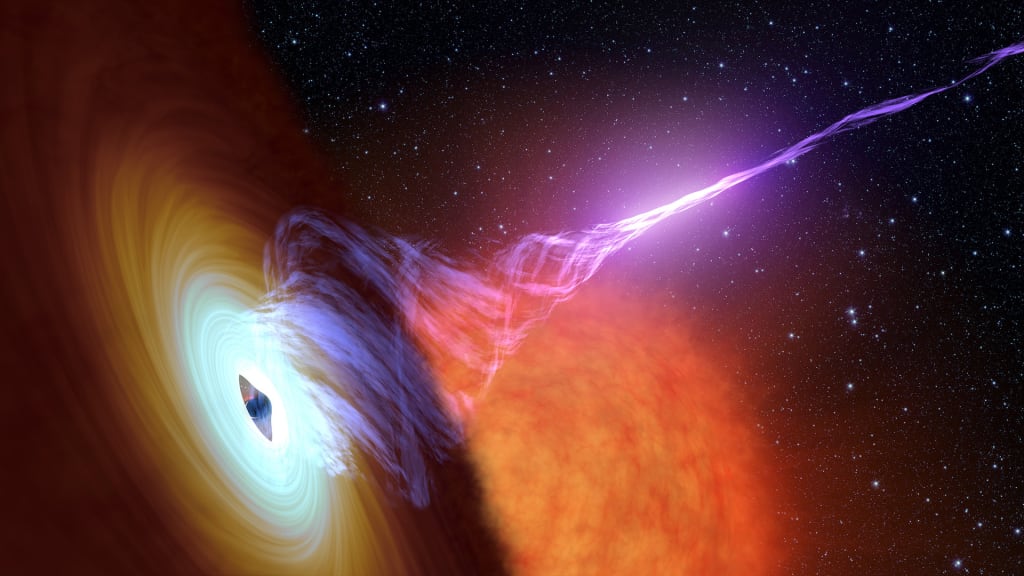Black Hole Jet Variations Contest the Leading Theory of Their Formation
Although there are numerous celestial entities with astronomical jets, none are as magnificent as those created by supermassive black holes. When particles from a black hole are propelled to practically the speed of light, structures up to millions of light-years in length are frequently produced. We do not understand how these patterns arise, and now a model that challenges our dominant one has emerged.

According to the current theory, these jets are stabilized as they extend far from the galaxy's center after being driven close to the supermassive black hole. X-rays are released by the accelerated charged particles, primarily electrons. It has been assumed that the stability of the jets is demonstrated by the stability of their X-ray emissions, however, a new study contends that this assumption is incorrect.
Nearly every jet observed by NASA's Chandra X-ray observatory was examined more than once by the researchers. 53 jets and around 155 distinctive locations within them made up the final sample. They discovered unexpected diversity in a short period of time. For a system that should be stable for millions of years, this is not what one would anticipate.
Observations of X-rays are frequently dependent on a finite number of photons. Strong statistical analysis was necessary for the study to prevent using randomness as a signal for variability. To determine the actual variability, lead author Eileen Meyer, an astronomer at the University of Maryland, Baltimore County, collaborated with statisticians from the Universities of Toronto and London. Between 30 and 100 percent of the jets will alter in the near future, they are certain.
"Pulling this result out of the data was almost like a miracle because the observations were not designed to detect it," Meyer said in a statement. "While we would like better constraints, it is clear that there is some variability."
According to the research, particles may potentially accelerate along the jet in addition to being driven close to the black hole. The study also indicates that earlier jets are more stable, perhaps as a result of variations in the nature of the cosmos at that time. The research questions the theory of X-ray generation in jets. "Hopefully this will be a real call to the theorists," Meyer continued, "to basically take a look at this result and come up with jet models that are consistent with what we're finding."
The results have been published in Nature Astronomy. One of the key findings of Chandra, the only X-ray observatory capable of sub-arcsecond-scale imaging, is unexpectedly strong X-ray emission from extragalactic radio jets on kiloparsec scales. It has been disputed for more than 20 years where this X-ray emission came from, which appears as a second spectral component from that of the radio emission.
Inverse-Compton upscattering of the cosmic microwave background by extremely low-energy electrons in a yet highly relativistic jet is the most widely accepted explanation for the phenomenon. There should be no variation in the X-ray emission under this process. Here, we provide results from a unique statistical analysis of 53 jets with multiple Chandra observations, which allowed us to discover X-ray variability in the large-scale jet population.
With a global P value of 1.96 104 under a Kolmogorov-Smirnov test against the predicted uniform (0, 1) distribution, we show that the distribution of P values from a Poisson model, taken as a population, is substantially inconsistent with continuous emission. These findings clearly suggest that synchrotron emission by a second population of electrons with multi-teraelectronvolt energy is the predominant mode of X-ray generation in kiloparsec-scale jets. Extremely tiny emitting volumes that are far smaller than the cross-section of the jet are implied by X-ray variability over timescales of a few months to many years.
About the Creator
Najmoos Sakib
Welcome to my writing sanctuary
I'm an article writer who enjoys telling compelling stories, sharing knowledge, and starting significant dialogues. Join me as we dig into the enormous reaches of human experience and the artistry of words.
Enjoyed the story? Support the Creator.
Subscribe for free to receive all their stories in your feed. You could also pledge your support or give them a one-off tip, letting them know you appreciate their work.






Comments
There are no comments for this story
Be the first to respond and start the conversation.